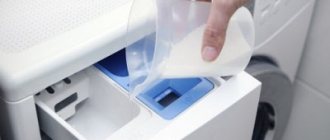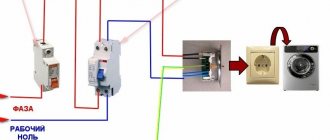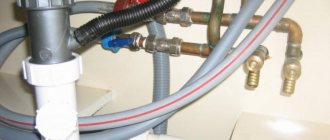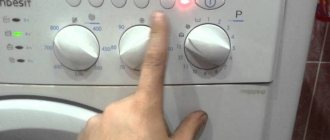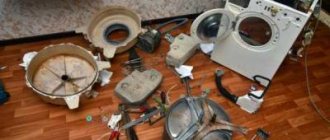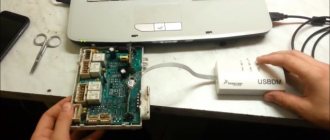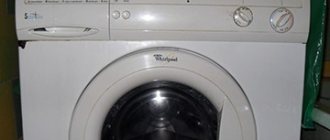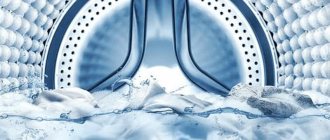Out of habit, have you loaded the laundry and gone about your business, only to return to find that foam is coming out of the washing machine? What could lead to such consequences? There is no need to hesitate: before finding out the cause of the breakdown, take immediate action.
How to deal with such a situation and how to troubleshoot the problem, read below.
Myth 1. The higher the water temperature in the washing machine, the better the clothes are washed.
It is a myth! Experts recommend washing colored and white, cotton or linen items at a temperature no higher than 60 degrees. When washing wool and silk, it is important to ensure that the temperature does not exceed 35-40 degrees. The higher the water temperature, the greater the chance that after washing a colored blouse will lose color, and a woolen sweater will not fit your size, but your child’s.
Comment by Alexander Galkin:
“I recommend choosing your wash temperature based on the type of fabric and degree of soiling, and remembering to pay attention to label recommendations.”
Breakage Prevention
Do not allow excess foam to form. For this:
- Choose a high-quality automatic washing powder for washing in the washing machine.
- Install a water filter. It will also protect the heating element from scale.
- Do not exceed the dose of powder. For lighter items, use even less product than usual.
Those who have modern washing machines at home should not worry. Manufacturers have provided a special program for foam control. If it is formed in excess, the pump pumps out the excess, after which the cycle continues.
Myth 2. If the powder doesn’t foam well, it means it doesn’t wash well.
And this is also a myth. There is no relationship between the quality of the washing powder and the amount of foam. Special substances are added to machine wash products to suppress excess foam, since excess foam can cause the washing machine to break down and the wash program to fail. Hand washing powders foam more, but this does not mean they wash better.
Comment by Alexander Galkin:
“Powders for automatic washing machines can also be used for hand washing, but you absolutely cannot do the opposite if you want your washing machine to last a long time.”
Why is there no foam?
Everyone is accustomed to the fact that when washing by hand, powders produce a lot of foam, which makes cleaning easier. However, such compounds cannot be used in a machine - excessive foaming is detrimental to the machine. There are many reasons: soap will come out of the drum onto the body and floor, and things won’t have time to rinse. Therefore, special concentrates with defoamers are produced for washing equipment.
Surfactants, or surfactants for short, are responsible for foaming, as well as for removing dirt. The more of these components in the detergent, the better the water foams and the faster stains are removed. There is only one “but” - soap solutions contain various electrolytes, which increases the electrical conductivity of the liquid to critical values. If there is too much foam in the drum, it will creep out and get on the dashboard or other elements of the system. As a result, a short circuit will occur - the equipment will break down irreparably.
Powders for automatic washing machines must contain special defoamers.
It is impossible to refuse surfactants, because otherwise the dirt will not be washed off. Chemists have found an alternative: adding defoamers to powders - substances that destroy foam. Thus, the product remains cleaning and does not threaten the equipment with a short circuit.
It cannot be argued that low foaming indicates high quality powder. Some unscrupulous manufacturers resort to deception: they do not add defoamers, but reduce the concentration of surfactants. Such compositions do not foam, but also do not wash. If there is no foam from the powder, then it is better to check the quality of the concentrate experimentally:
- wash by hand, assessing the effectiveness of the composition and the speed of stain removal;
- dissolve the concentrate in water;
- watch how the product is washed out of the tray.
Determining the quality of a powder by the amount of foam is irrational. It contains other components that also affect stain removal. The maximum effectiveness of the concentrate composition can only be assessed in the laboratory through numerous studies. You definitely can’t add only highly foaming products to the tray.
Myth 3. Powder can leave streaks on clothes after washing.
Another myth! In most cases, the reason for the appearance of powder stains on clothes after washing lies in the incorrect dosage of powder or overloading of the washing machine drum. The right dosage can do wonders for your laundry! It is worth remembering: if you put too much detergent, you will not achieve the best effect; If you put too little, you will not get the desired result when removing dirt.
Comment by Alexander Galkin:
“Each package of Persil contains recommendations for the correct dosage. Remember that the choice of the correct dosage and the quality of washing directly depend on three factors: the amount of laundry to be washed, the degree of contamination and water hardness.”
Possible causes that you can eliminate yourself
Most often, an excess of foam is not associated with a breakdown of the machine. The reasons are hidden in powder, water or washable items.
When is the powder to blame?
- Dosage error. When you poured in more powder than needed. For example, they took a concentrated powder and measured it as usual.
- Wrong type of powder. Some housewives manage to pour hand washing detergent into the SMA, which foams more.
- Low quality detergents. Unfortunately, counterfeits are also found among household chemicals. It is impossible to guess how a fake powder will behave, so it is better not to buy laundry detergents from unknown brands.
When the cause is a clog or laundry
- The hardness of the water has changed after installing a softening filter . The amount of powder depends both on the load of the washing machine and on the hardness of the water. If you made repairs and installed a softening filter, the dosage of detergent should be reduced. In soft water, the old dosage of powder will produce excess foam.
- The drain or water intake path is clogged with detergent residues. Excess foam is formed due to detergent residues from previous washes. First of all, they clog the drain filter, filler or drain pipes. The drain filter requires regular cleaning. If you haven’t looked into it for a long time, and the machine is rioting with foam, then you need to unscrew it and clean it. The filler and drain pipes also require cleaning. If you are afraid to get into the car yourself, call a technician to clean them.
- "Foaming" things. Tulle, filled blankets and onesies, and loose textured bedspreads work as foaming agents due to their perforated structure and the larger volume of air they bring into the tank. To wash such laundry, the amount of powder must be reduced.
Myth 4. The more clothes in the washing machine, the worse the powder washes.
The quality of washing directly depends on the correct loading of the washing machine. And it’s not all about the washing powder. Only the correct loading of the drum and the correct dosage will provide you with truly high-quality washing.
Comment by Alexander Galkin:
“For my part, I advise you to avoid overloading the washing machine: in this case, the mechanical impact on the laundry will be much less, and the quality of washing will noticeably deteriorate. Also, if overloaded, the rinsing efficiency will decrease. The basic rule: between the laundry and the upper wall of the drum there should be a distance equal to the width of your palm.”
What to do if the machine does not turn on after removing the foam?
Have you cleaned your washer but can't turn it on to rinse it? Aquastop may be to blame for the “strike”. Until you completely remove the water from the pan, the automation will not give the go-ahead to turn on the SMA.
There is no aquastop, but the car still won’t turn on? It is possible that foam has flooded the contacts or made its way into the control unit. Then you will have to wait a day or a little more until everything dries, as in the situation with a wet cell phone.
The control module is faulty - from 1800 rubles*
Idle time and drying didn't help? This means that the module not only got wet, but failed. In this case, a technician is needed to carry out diagnostics and find the cause of the control unit failure.
* The price does not include parts; if necessary, they are paid separately.
Have you noticed that there is foam coming out of the washing machine? Call Wash Man! We will advise you on the breakdown, neutralize the foam, if necessary, repair it within 24 hours after the application at home, issue a guarantee for work and spare parts for up to 2 years.
Myth 6. Traditional laundry detergents are more effective than the latest developments.
Different types of fabrics require different approaches before, during and after washing. For example, a wool sweater requires a different product, care, and washing routine than cotton bedding. Modern science does not stand still: new ingredients are constantly being developed, on the basis of which more and more modern laundry products are created, for example, the innovative Persil Expert Tabs. Persil Expert Tabs are compact tablets that are twice as concentrated as traditional powders. Upon contact with water, the tablets quickly dissolve and immediately begin to act on contaminants. Unlike conventional detergents, Persil Expert Tabs allows you to avoid manually measuring the amount of powder - the dosage is provided in advance: for one wash, two Persil tablets are enough, which are placed in the dispenser of the washing machine.
Comment by Alexander Galkin:
“Today, Persil Expert Tabs is one of the most innovative premium products, closing the evolutionary chain of laundry detergents. We expect that with the release of Persil Expert Tabs to the market, Russian housewives will be able to spend less time on household chores.”
How to troubleshoot
How much foam should there be when washing? Enough to wash clothes. But if it starts to climb through the top of the washing machine, the cause is a faulty cuff.
The sealing rubber is responsible for sealing the hatch and protects against water leaks. The cuff could be damaged during washing by a foreign object or become loose over time. Rubber is also affected by mold and mildew.
Did the foam leak out from the top or from under the car? This means that the inner part of the rubber is damaged. It urgently needs to be replaced.
You can buy a replacement for a worn cuff in an online store, indicating the brand and model of the washer.
- Open the hatch door.
- Unscrew the screws securing the UBL lock.
- Bend the rubber and remove the outer clamp.
- To remove the inner clamp, remove the top cover of the CMA by unscrewing the two screws at the back.
- Remove the cuff from the tank.
Clean all grooves in the rubber area, then install a new element.
When it is noticeable that soapy water is flowing and protruding under the machine, the reason may be a malfunction of the drainage system.
- The water must be removed immediately. We described above how to extinguish and remove foam.
- Inspect the entire system, from the drain filter to the pump.
- Remove the back panel of the washer by unscrewing the bolts around the perimeter.
- Inspect the drain pipe. If it is damaged or leaky, it may leak foam.
- Unscrew the bolt and loosen the pipe clamp.
- Disconnect and replace element.
The drain pump is also checked there. The drain hose and its attachment to the sewer are inspected. If any connectors have come loose, they need to be secured more firmly.
Advantages of contacting the Remontano workshop
- Quick visit of a specialist to your home. Apply online.
- Guarantee for all types of services provided.
- We use original spare parts from official suppliers.
- Providing services at a time convenient for the customer.
- The cost is below the market average in the capital region.
- Orders are accepted for the restoration of both domestic and imported equipment.
Procedure for excess foam
The detailed procedure for filling a washing machine with abundant foam is as follows:
- Press the button to stop the washing mode: “Pause”.
- Switch to the “Water Drain” mode: the machine will unlock the door only after the liquid has completely drained from the system.
- Empty the drum and repeat rinsing until the foam is completely eliminated.
Now it remains to find out the reason for this behavior of the equipment and eliminate the damage caused during operation or wear of parts.
Leave a request and the technician will diagnose your washing machine today.
